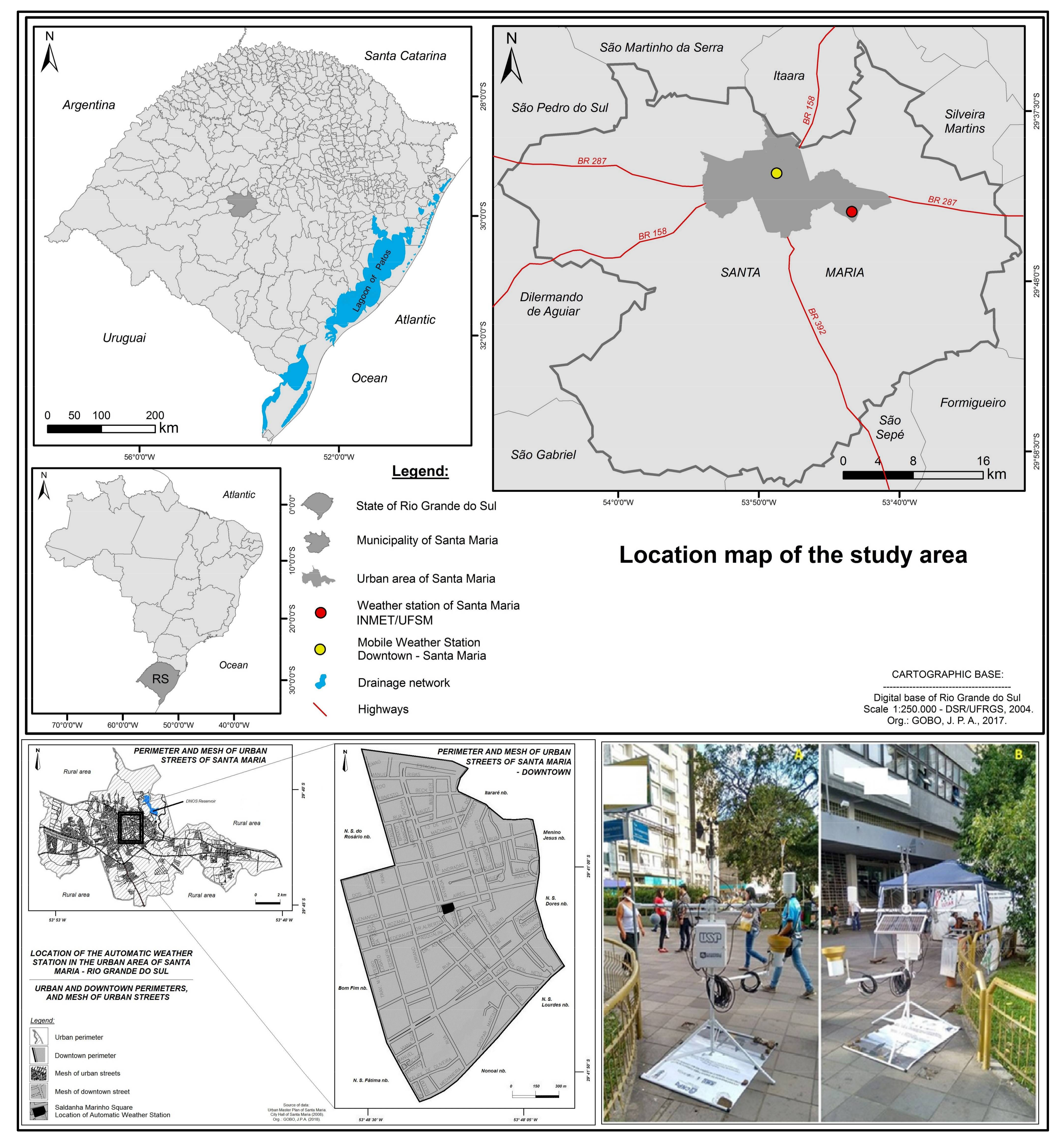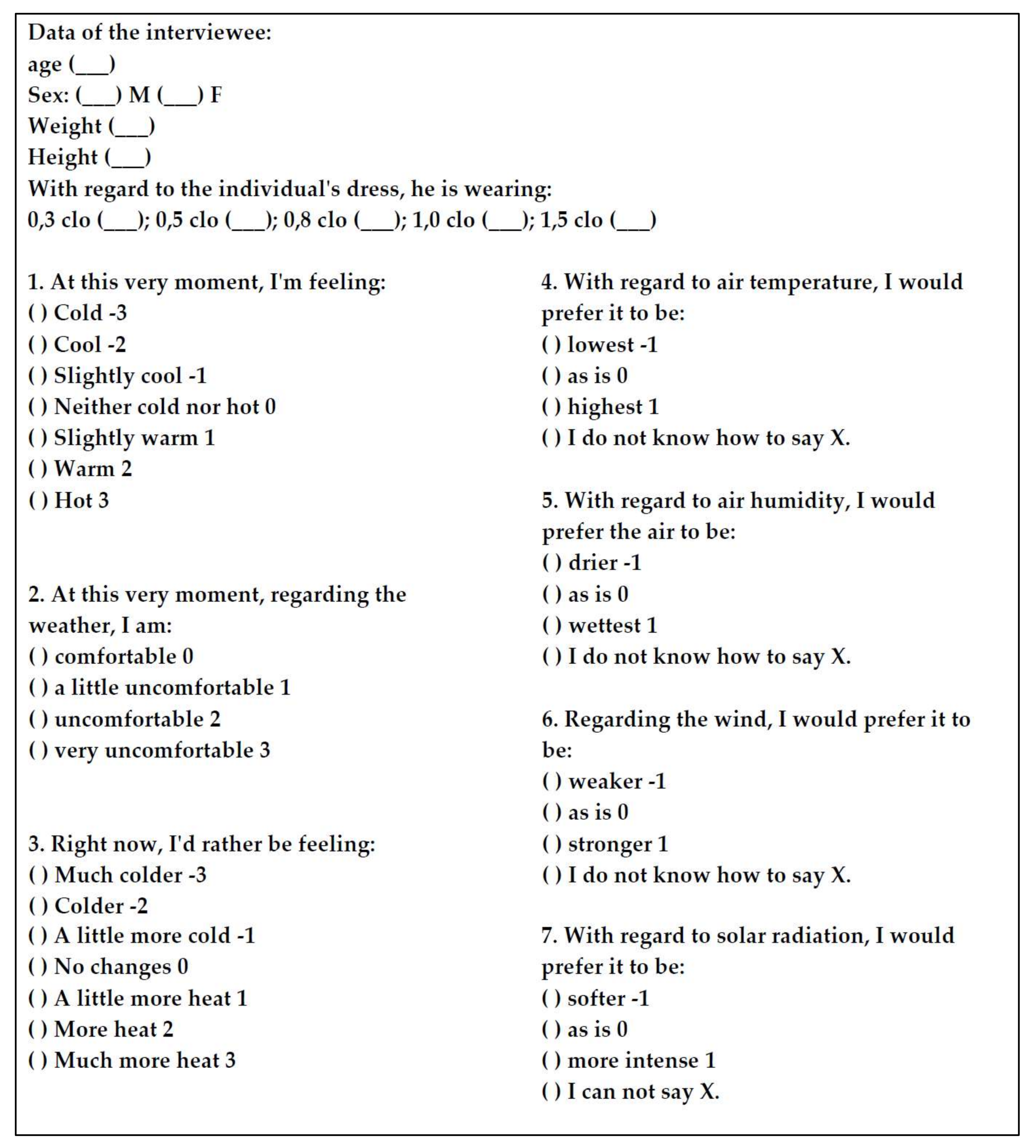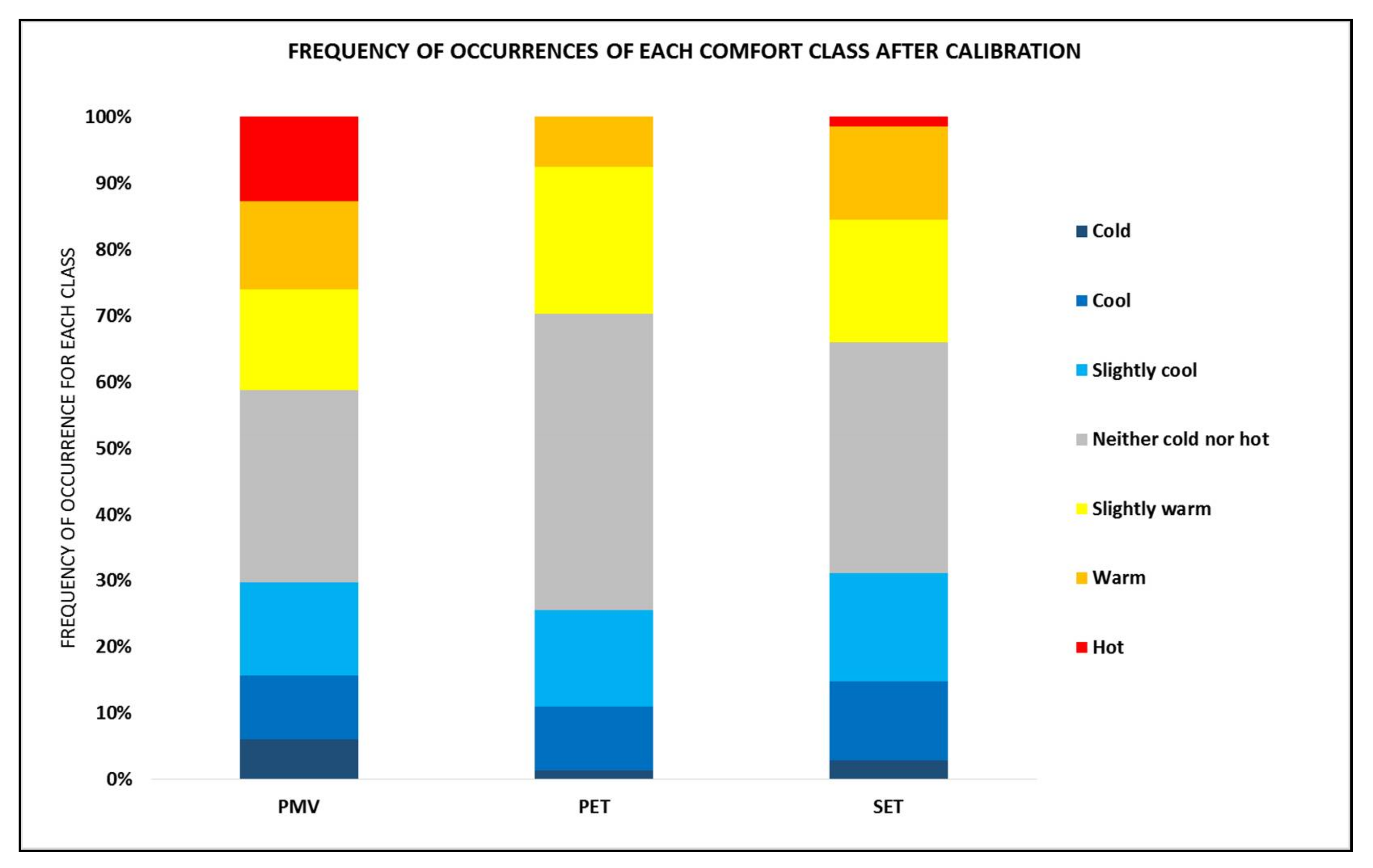Subjective Human Perception of Open Urban Spaces in the Brazilian Subtropical Climate: A First Approach
Abstract
:1. Introduction
2. Materials and Methods
3. Results
3.1. Calibration of Interpretive Ranges for the Predicted Mean Vote (PMV)
3.2. Calibration of Interpretive Ranges for the New Standard Effective Temperature (SET)
3.3. Calibration of Interpretive Ranges for the Physiological Equivalent Temperature (PET)
3.4. Analysis–Synthesis of the Calibration Suggested for the Interpretive Ranges of the PET, SET, and PMV
4. Conclusions
Acknowledgments
Author Contributions
Conflicts of Interest
References
- Höppe, P. Different aspects of assessing indoor and outdoor thermal comfort. Energy Build. 2002, 34, 661–665. [Google Scholar] [CrossRef]
- Lai, D.; Guo, D.; Hou, Y.; Lin, C.; Chen, Q. Studies of outdoor thermal comfort in northern China. Build. Environ. 2014, 77, 110–118. [Google Scholar] [CrossRef]
- International Organization for Standardization (ISO). Ergonomics of the Thermal Environment—Assessment of the Influence of the Thermal Environment Using Subjective Judgement Scales; ISO 10551; ISO: Geneva, Switzerland, 1995. [Google Scholar]
- International Organization for Standardization (ISO). Ergonomics of the Thermal Environment—Instruments for Measuring Physical Quantities; ISO 7726; ISO: Geneva, Switzerland, 1998. [Google Scholar]
- Johansson, E.; Thorsson, S.; Emmanuel, R.; Krüger, E. Instruments and methods in outdoor thermal comfort studies e the need for standardization. Urban Clim. 2014, 10, 346–366. [Google Scholar] [CrossRef]
- Bröde, P.; Krüger, E.L.; Rossi, F.A.; Faila, D. Predicting urban outdoor thermal comfort by the Universal Thermal climate index UTCI—A case study in Brazil. Int. J. Biometeorol. 2012, 56, 471–480. [Google Scholar] [CrossRef] [PubMed]
- Rossi, F.A.; Krüger, E.L.; Bröde, P. Definição de faixas de conforto e desconforto térmico para espaços abertos em Curitiba, PR, com o índice UTCI. Ambiente Construído 2012, 12, 41–59. [Google Scholar] [CrossRef]
- Zambrano, L.; Malafaia, C.; Bastos, L.E.G. Thermal Comfort Evaluation in Outdoor Space of Tropical Humid Climate. In Proceedings of the PLEA 23rd Conference on Passive and Low Energy Architecture, Geneva, Switzerland, 6–8 September 2006. [Google Scholar]
- Rossi, F.A.; Krüger, E.L.; Guimarães, I.A. Modelo preditivo de sensação térmica em espaços abertos em Curitiba, PR. Ra’e Ga. 2013, 29, 209–238. [Google Scholar] [CrossRef]
- Gulyas, A.; Unger, J.; Matzarakis, A. Assessment of the microclimatic and human comfort conditions in a complex urban environment: Modelling and measurements. Build. Environ. 2006, 41, 1713–1722. [Google Scholar] [CrossRef]
- Cheng, V.; Ng, E. Thermal comfort in urban open spaces for Hong Kong. Archit. Sci. Rev. 2006, 49, 236–242. [Google Scholar] [CrossRef]
- Spagnolo, J.; Dear, R. A field study of thermal comfort in outdoor and semi-outdoor environments in subtropical Sydney Australia. Build. Environ. 2003, 38, 721–738. [Google Scholar] [CrossRef]
- Gagge, A.P.; Stolwijk, J.A.J.; Nish, Y. An effective temperature scale based on a simple model of human physiological regulatory response. ASHRAE Trans. 1971, 77, 247–263. [Google Scholar]
- Fanger, P.O. Thermal Comfort; McGraw-Hill Book Company: New York, NY, USA, 1970. [Google Scholar]
- Höppe, P. The physiological equivalent temperature: A universal index for the assessment of the thermal environment. Int. J. Biometeorol. 1999, 43, 71–75. [Google Scholar] [CrossRef] [PubMed]
- Pantavou, K.; Theoharatos, G.; Santamouris, M.; Asimakopoulos, D. Outdoor thermal sensation in a Mediterranean climate and a comparison with UTCI. Build. Environ. 2013, 66, 82–95. [Google Scholar] [CrossRef]
- Lin, T.P.; Dear, R.; Hwang, R.L. Effect of thermal adaptation on seasonal outdoor thermal comfort. Int. J. Climatol. 2011, 31, 302–312. [Google Scholar] [CrossRef]
- Farajzadeh, H.; Saligheh, M.; Alijani, B.; Matzarakis, A. Comparison of selected thermal indices in the northwest of Iran. Nat. Environ. Chang. 2015, 1, 1–20. [Google Scholar]
- Nasira, R.A.; Ahmada, S.S.; Ahmedb, A.Z. Psychological Adaptation of Outdoor Thermal Comfort in Shaded Green Spaces in Malaysia. Procedia Soc. Behav. Sci. 2012, 68, 865–878. [Google Scholar] [CrossRef]
- Yang, W.; Wong, N.H.; Jusuf, S.K. Thermal comfort in outdoor urban spaces in Singapore. Build. Environ. 2013, 59, 426–435. [Google Scholar] [CrossRef]
- Villadiego, K.; Velay-Dabat, M.A. Outdoor thermal comfort in a hot and humid climate of Colombia: A field study in Barranquilla. Build. Environ. 2014, 75, 142–152. [Google Scholar] [CrossRef]
- Hirashima, S.; Katzschner, A.; Ferreira, D.; Assis, E.S.; Katzschner, L. Thermal comfort comparison and evaluation in different climates Toulouse, Françe. In Proceedings of the 9th International Conference on Urban Climate (ICUC), Toulouse, France, 20–24 July 2015. [Google Scholar]
- Lucchese, J.R.; Mikuri, L.P.; De Freitas, N.V.S.; Andreasi, W.A. Application of selected indices on outdoor thermal comfort assessment in Midwest Brazil. Int. J. Energy Environ. 2016, 7, 291–302. [Google Scholar]
- Krüger, E.L.; Rossi, F.A.; Drach, P. Calibration of the physiological equivalent temperature index for three different climatic regions. Int. J. Biometeorol. 2017, 61, 1323–1336. [Google Scholar] [CrossRef] [PubMed]
- Hirashima, S.Q.S.; Assis, E.S.; Nikolopoulou, M. Daytime thermal comfort in urban spaces: A field study in Brazil. Build. Environ. 2016, 107, 245–253. [Google Scholar] [CrossRef]
- Zeng, Y.; Dong, L. Thermal human biometeorological conditions and subjective thermal sensation in pedestrian streets in Chengdu, China. Int. J. Biometeorol. 2015, 59, 99–108. [Google Scholar] [CrossRef] [PubMed]
- Golasi, I.; Salata, F.; de Lieto Vollaro, E.; Coppi, M. Complying with the demand of standardization in outdoor thermal comfort: A first approach to the Global Outdoor Comfort Index (GOCI). Build. Environ. 2018, 130, 104–119. [Google Scholar] [CrossRef]
- Lin, T.P. Thermal perception, adaptation and attendance in a public square in hot and humid regions. Build. Environ. 2009, 44, 2017–2026. [Google Scholar] [CrossRef]
- Cheng, V.; Ng, E.; Chan, C.; Givoni, B. Outdoor thermal comfort study in sub-tropical climate: A longitudinal study based in Hong Kong. Int. J. Biometeorol. 2012, 56, 43–56. [Google Scholar] [CrossRef] [PubMed]
- Chen, L.; Wen, Y.; Zhang, L.; Xiang, W.N. Study of thermal comfort and space use in an urban park square in cool and cold seasons in Shanghai. Build. Environ. 2015, 94, 644–653. [Google Scholar] [CrossRef]
- Li, K.; Zhang, Y.; Zhao, L. Outdoor thermal comfort and activities in the urban residential community in a humid subtropical area of China. Energy Build. 2016, 133, 498–511. [Google Scholar] [CrossRef]
- Liu, W.; Zhang, Y.; Deng, Q. The effects of urban microclimate on outdoor thermal sensation and neutral temperature in hot-summer and cold-winter climate. Energy Build. 2016, 128, 190–197. [Google Scholar] [CrossRef]
- Zhao, L.; Zhoua, X.; Li, L.; Heb, S.; Chena, R. Study on outdoor thermal comfort on a campus in a subtropical urban area in summer. Sustain. Cities Soc. 2016, 22, 164–170. [Google Scholar] [CrossRef]
- Jeong, M.A.; Park, S.; Song, G.S. Comparison of human thermal responses between the urban forest area and the central building district in Seoul, Korea. Urban For. Urban Green. 2016, 15, 133–148. [Google Scholar] [CrossRef]
- Song, G.S.; Jeong, M.A. Morphology of pedestrian roads and thermal responses during summer, in the Urban area of Bucheon city, Korea. Int. J. Biometeorol. 2016, 60, 999–1014. [Google Scholar] [CrossRef] [PubMed]
- Nikolopoulou, M.; Baker, N.; Steemers, K. Thermal comfort in outdoor urban spaces: Understanding the human parameter. Sol. Energy 2001, 70, 227–235. [Google Scholar] [CrossRef]
- International Organization for Standardization (ISO). Ergonomics of the Thermal Environment—Estimation of Thermal Insulation and Water Vapour Resistance of a Clothing Ensemble; ISO 9920; ISO: Geneva, Switzerland, 2007. [Google Scholar]
- International Organization for Standardization (ISO). Ergonomics of the Thermal Environment—Determination of Metabolic Rate; ISO 8996; ISO: Geneva, Switzerland, 2004. [Google Scholar]
- Matzarakis, A. Modelling radiation fluxes in simple and complex environments—Application of the RayMan model. Int. J. Biometeorol. 2007, 51, 323–334. [Google Scholar] [CrossRef] [PubMed]
- Matzarakis, A. Climate Change: Temporal and spatial dimension of adaptation possibilities at regional and local scale. In Tourism and the Implications of Climate Change: Issues and Actions; Schott, C., Ed.; Emerald Group Publishing: Bingley, UK, 2010; Volume 3, pp. 237–259. [Google Scholar]
- Neter, J.; Wasserman, W.; Kutner, M.H. Applied Linear Statistical Models: Regression, Analysis of Variance, and Experimental Designs; IRWIN: Burr Ridge, IL, USA, 1990. [Google Scholar]
- Ansi/Ashrae. Standard 55: Thermal Environmental Conditions for Human Occupancy; American Society of Heating, Refrigerating and Air-conditioning Engineers: Atlanta, GA, USA, 2004. [Google Scholar]
- Höppe, P. Die Physiologisch Äquivalente Temperatur PET. Ann. Meteorol. 1997, 33, 108–112. [Google Scholar]
- Jendritzky, G.; Sönning, W.; Swantes, H.J. Ein Objektives Bewertungsverfahren zur Beschreibung des Thermischen Milieus in der Stadt- und Landschaftsplanung (‘Klima-Michel-Modell’); Beiträge der Akademie für Raumforschung und Landesplanung, Bd. 28; Akademic für Raumforschung und Lancksplanung: Hannover, Germany, 1979. [Google Scholar]
- Monteiro, L.M. Modelos Preditivos de Conforto Térmico: Quantificação de Relações Entre Variáveis Microclimáticas e de Sensação Térmica Para Avaliação e Projeto de Espaços Abertos. Ph.D. Thesis, Universidade de São Paulo, São Paulo, Brazil, 2008. [Google Scholar]
- Xi, T.; Li, Q.; Mochida, A.; Meng, Q. Study on the outdoor thermal environment and thermal comfort around campus clusters in subtropical urban areas. Build. Environ. 2012, 52, 162–170. [Google Scholar] [CrossRef]
- Jendritzky, G. Selected Questions of Topical Interest in Human Bioclimatology. Int. J. Biometeorol. 1991, 35, 139–150. [Google Scholar] [CrossRef] [PubMed]
- Kántor, N.; Kovács, A.; Takács, Á. Seasonal differences in the subjective assessment of outdoor thermal conditions and the impact of analysis techniques on the obtained results. Int. J. Biometeorol. 2016, 60, 1615–1635. [Google Scholar] [CrossRef] [PubMed]



| Thermal Comfort Level | Score | Index | Hit Rate |
|---|---|---|---|
| Cold | (−∞; −2.379] | PMV | 35.9% |
| Cool | (−2.379; −1.335] | PET | 32.8% |
| Slightly cool | (−1.335; −0.254] | SET | 34.6% |
| Neither cold nor hot | (−0.254; 0.965] | ||
| Slightly warm | (0.965; 1.412] | ||
| Warm | (1.412; 2.040] | ||
| Hot | (2.040; +∞) |
| PMV Jendritzky et al. (1979) | Calibrated PMV | ||
|---|---|---|---|
| >2.5 | Hot | <−3.6 | Cold |
| 1.5 to 2.5 | Warm | −3.6 to −2.3 | Cool |
| 0.5 to 1.5 | Slightly warm | −2.3 to −1.0 | Slightly cool |
| −0.5 to 0.5 | Comfortable | −1.0 to 0.8 | Neither cold nor hot |
| −1.5 to −0.5 | Slightly cool | 0.8 to 1.9 | Slightly warm |
| −2.5 to −1.5 | Cool | 1.9 to 3.5 | Warm |
| <−2.5 | Cold | >3.5 | Very warm |
| Calibrated SET | |
|---|---|
| <6 | Cold |
| 6–12 | Cool |
| 12–17 | Slightly cool |
| 17–23 | Neither cold nor hot |
| 23–29 | Slightly warm |
| 29–33 | Warm |
| >33 | Hot |
| PET Jendritzky (1991) | Calibrated PET | ||
|---|---|---|---|
| <4 | Cold | <5 | Cold |
| 4–8 | Cool | 5–11 | Cool |
| 8–18 | Moderately cool | 11–16 | Slightly cool |
| 18–23 | Comfortable | 16–24 | Neither cold nor hot |
| 23–35 | Moderately hot | 24–30 | Slightly warm |
| 35–41 | Warm | 30–39 | Warm |
| >41 | Hot | >39 | Hot |
© 2018 by the authors. Licensee MDPI, Basel, Switzerland. This article is an open access article distributed under the terms and conditions of the Creative Commons Attribution (CC BY) license (http://creativecommons.org/licenses/by/4.0/).
Share and Cite
Gobo, J.P.A.; Galvani, E.; Wollmann, C.A. Subjective Human Perception of Open Urban Spaces in the Brazilian Subtropical Climate: A First Approach. Climate 2018, 6, 24. https://doi.org/10.3390/cli6020024
Gobo JPA, Galvani E, Wollmann CA. Subjective Human Perception of Open Urban Spaces in the Brazilian Subtropical Climate: A First Approach. Climate. 2018; 6(2):24. https://doi.org/10.3390/cli6020024
Chicago/Turabian StyleGobo, João Paulo Assis, Emerson Galvani, and Cássio Arthur Wollmann. 2018. "Subjective Human Perception of Open Urban Spaces in the Brazilian Subtropical Climate: A First Approach" Climate 6, no. 2: 24. https://doi.org/10.3390/cli6020024
APA StyleGobo, J. P. A., Galvani, E., & Wollmann, C. A. (2018). Subjective Human Perception of Open Urban Spaces in the Brazilian Subtropical Climate: A First Approach. Climate, 6(2), 24. https://doi.org/10.3390/cli6020024







